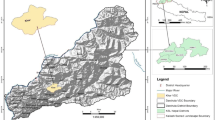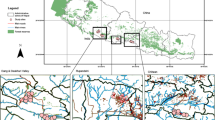Abstract
This study examined traditional harvesting knowledge and practices, paired with field-based assessment of distribution of a vulnerable wild medicinal root, Anacyclus pyrethrum var. pyrethrum, in southern Morocco. Research included focus groups, qualitative interviews, and a survey of 38 collectors. Based on local knowledge, replanting trials were conducted and transects and plot-based assessments were used to examine distribution.
Local collectors reported significant declines in A. pyrethrum var. pyrethrum populations, driven by poaching and premature (either before the root has become large enough or before the season of seed dispersal) harvesting in sites that cannot be protected from poaching, as well as grazing and tilling. Thirty sites, totaling approximately 30% of the region, were surveyed: A. pyrethrum var. pyrethrum was identified in only nine. In five sites, plot transects were used to determine plant density, revealing that plant density and the number of flowers and fruit per plant were significantly higher closest to habitation.
This research contributes to the understanding and evaluation of the causes of over harvesting and factors that could help to protect this vulnerable species. We believe that there is significant room to build on local collector’s knowledge of harvesting and management of this important natural resource, with potential benefits for both local livelihoods and local ecosystems.
Cette étude a examiné les connaissances et les pratiques traditionnelles de collecte, associées à une évaluation de la distribution en fonction du milieu, d’une racine médicinale spontanée et vulnérable d’Anacyclus pyrethrum var. pyrethrum dans le sud du Maroc. L’étude a porté sur des groupes de discussion, des entrevues qualitatives et une enquête auprès de 38 collecteurs. En se basant sur les connaissances locales, nous avons effectué des essais de replantation et nous avons utilisé des transects et des évaluations fondées sur des parcelles pour examiner la distribution de l’espèce. Les collecteurs locaux ont signalé une réduction significative des populations d’A. pyrethrum var. pyrethrum, engendrée essentiellement par le braconnage et la collecte prématurée (soit avant que la racine soit suffisamment grande, soit avant la saison de dispersion des graines), dans les sites qui ne peuvent pas être protégés contre ce braconnage et aussi contre le pâturage et le labourage. Sur trente sites prospectés, représentant 30% de la région, l’A. pyrethrum var. pyrethrum a été trouvé dans uniquement neuf. Dans cinq sites, nous avons utilisé des transects pour déterminer la densité de l’espèce, ce qui a révélé que cette densité et le nombre de fleurs et de fruits par plante étaient significativement plus élevés dans les endroits les plus proches des habitations. Cette recherche contribue à la compréhension et à l’évaluation des causes de la surexploitation et des facteurs qui pourraient aider à protéger cette espèce vulnérable. Nous croyons qu’il est. tout à fait possible de tirer parti des connaissances des collecteurs locaux.



Similar content being viewed by others
Literature Cited
Anderson, K. 2006. Tending the wild: Native American knowledge and the management of California’s natural resources. University of California Press, Berkeley
Azelmat, M., Ayad, M., and Abdelmoneim, A. 2005. Enquête sur la Population et la Santé Familiale (EPSF) 2003/04. Ministère de la Santé du Royaume du Maroc, ORC Macro, & Projet PAPFAM. Morocco and Calverton USA and Cairo, Egypt, Rabat, Maroc. http://dhsprogram.com/pubs/pdf/FR155/FR155.pdf.
Badhe S.R., Badhe, R.V., Ghaisas, M.M., Chopade, V.V., and Deshpande, A.D. 2010. Evaluations of antidepressant activity of Anacyclus pyrethrum root extract. International Journal of Green Pharmacy 4(2): online.
Belcher, B., Ruiz Perez, M., and Achdiawan, R. 2005. Global patterns and trends in the use and management of commercial NTFPs: Implications for livelihoods and conservation. World Development 9: 1435–1452.
Bellakhdar, J. 1997. La Pharmacopée Marocaine Traditionnelle: Médicine Arabe Ancienne et Savoirs Populaires. Ibis Press, Casablanca.
Bello, M.A., Alvarez, I., Torices, R. and Fuertes-Aguilar, J. 2013. Floral development and evolution of capitulum structure in Anacyclus (Anthemideae, Asteraceae). Annals of Botany 112(8): 1597–612.
Bernard, R.H. 2002. Research methods in anthropology: Qualitative and quantitative approaches. Altamira Press, Walnut Creek, CA.
Bitariho, R., McNeilage, A., Babaasa, D. and Barigyira, R. 2006. Plant harvest impacts and sustainability in Bwindi Impenetrable National Park, S.W. Uganda. African Journal of Ecology 44(1): 14–21.
Boulos, L. 1983. Medicinal plants of North Africa. Reference Publications, Algonac.
Castle, L. M. 2006. The prairie turnip paradox: Contributions of population dynamics, ethnobotany, and community ecology to understanding Pediomelum esculentum root harvest on the Great Plain. Ph.D. Thesis, Kansas University, USA.
Chaouki, S., Medjdoub, H., Dib, M.A., Zerriouh, M., and Tabti, B. 2012. Anti-diabetic activity of aqueous root extract of Anacyclus pyrethrum L. in streptozotocin-induced-diabetic rats. Journal of Medicinal Plants Research 6: 3193–3198.
Couvreur, G. 1968. La vie pastorale dans le Haut Atlas Central. Revue de Géographie du Maroc 13: 3–47.
-----, M., Cunningham, A.B., and Schippmann, U. 1997. Trade in Prunus africana, and the implementation of CITES. Bundesamt für Naturschutz, Bonn
Cunningham, A.B., and Mbenkum, F.T. 1993 Sustainability of harvesting Prunus africana bark in Cameroon: A medicinal plant in international trade. People and Plants Working Paper 2, UNESCO, Paris.
Dhillion, S.S. and Gustad, G. 2004. Local management practices influence the viability of the baobab (Adansonia digitata Linn.) in different land use types, Cinzana, Mali. Agriculture, Ecosystems & Environment 101(1): 85–103.
Direction des Etudes et des Prévisions Financières. 2016. Tableau de bord social. Ministère de l’Economie et des Finances, Rabat, Maroc. https://www.finances.gov.ma/Docs/depf/2016/TB%20social%202016.pdf.
Dominguez, P., Bourbouze, A., Demay, S., Genin, D. and Kosoy, N. 2012. Diverse ecological, economic and socio-cultural values of a traditional common natural resource management system in the Moroccan High Atlas: The Aït Ikiss Tagdalts. Environmental Values 21(3): 277--296.
Farooquee, N.A., Majila, B.S. and Kala, C.P. 2004. Indigenous knowledge systems and sustainable management of natural resources in a high altitude society in Kumaun Himalaya, India. Human Ecology 16: 33–42.
Ghimire, S.K., McKey, D. and Aumeeruddy-Thomas, Y. 2005. Conservation of Himalayan medicinal plants: Harvesting patterns and ecology of two threatened species, Nardostachys grandiflora DC. and Neopicrorhiza scrophulariiflora (Pennell) Hong. Biological Conservation 124(4): 463–475.
Greger, H. 1978. Comparative phytochemistry and systematics of Anacyclus. Biochemical Systematics and Ecology 6:11–17.
Gunatilleke, I.A.U.N., Gunatilleke C.V.S. and Abeygunawardena, P. 1993. Interdisciplinary research towards management of non-timber forest resources in lowland rain forests of Sri Lanka. Economic Botany 47: 282–290.
Hall, P. and Bawa K. 1993. Methods to assess the impact of extraction of non-timber tropical forest products on plant populations. Economic Botany 47(3): 234–247.
Humphries, C.J. 1979. A revision of the genus Anacyclus L. (Compositae: Anthemideae) Bull. British Museum (Natural History) (Bot.) 7:83–142.
Ilahiane, H. 1999. The Berber Agdal institution: Indigenous range management in the Atlas Mountains. Ethnology 38: 21–45.
Jacobson, M. 1982. Plants, insects, and man—their interrelationships. Economic Botany 36:346–354.
Kaleta, R. 2008. The cultural significance of Thuya (Tetraclinus articulata): An ethnographic study of the Thuya woodworking craft and its implications for sustainable management in southern Morocco. Ph.D. Thesis, University of Kent, Canterbury, England.
Kumar, S. 2002. Methods for community participation: a complete guide for practitioners. Vistaar Publications, New Delhi.
Lahssini, S., Hajib, S., Lahlaoi, H., Alaoui, H.M. and Khattabi, A. 2015. Modeling spatial distribution of the Carob Tree (Ceratonia siliqua L.) in Azilal Province, Morocco. Journal of Geography and Geology 7: 33–44.
Lecestre-Rollier, B. 1992. Anthropologie d’un espace montagnard: Les Ait Bouguemez du Haut Atlas marocain. Ph.D. Thesis, Paris V University, Paris, France.
Martin, G. J. 2004. Ethnobotany: A methods manual: People and Plants Conservation series. Earthscan, London.
Médail, F. and Quézel, P. 1999. Biodiversity hotspots in the Mediterranean Basin: Setting global conservation priorities. Conservation Biology 13(6): 1510–1513.
Ministère de la Santé et ORC, Maroc. 2005. Enquête sur la population et la santé familiale (EPSF) 2003–2004. Ministère de la Santé et ORC Maroc, Rabat, Maroc.
Myers, N., Mittermeier, R.A., Mittermeier, C.G., Fonsecaand, G.A.B D. and Kent, J. 2000. Biodiversity hotspots for conservation priorities. Nature 403: 853–858.
Ostrom, E. 1990. Governing the commons: The evolution of institutions for collective action. Cambridge University Press, London
Ouarghidi, A., Powell, B., Martin, G.J., Boer, H.D. and Abbad, A. 2012. Species substitution in medicinal roots and possible implications for toxicity in Morocco. Economic Botany 66: 370–382.
------, A. 2013. Evaluation taxonomique et analyse de l’impact de la commercialisation des racines sur la conservation des plantes médicinales dans la région de Marrakech. Ph.D. Thesis, Cadi Ayyad University, Marrakech, Morocco.
Pahuja, M., Mehla, J., Reeta, K.H., Joshi, S. and Gupta, Y.K. 2012. Root extract of Anacyclus pyrethrum ameliorates seizures, seizure-induced oxidative stress and cognitive impairment in experimental animals. Epilepsy research 98: 157–165.
Rankou, H., Ouhammou, A., Taleb, M., Manzanilla, V. and Martin, G. 2015. Anacyclus pyrethrum. The IUCN Red List of Threatened Species 2015: e.T202924A53798702. Downloaded on 07 November 2016 (http://dx.doi.org/10.2305/IUCN.UK.2015-4.RLTS.T202924A53798702.en.).
Reid, L.A. 2005. The effects of traditional harvesting practices on restored sweet grass populations. MSc. Thesis, New York University, USA.
Shebitz, D.J., Reichard, S.H. and Dunwiddie, P.W. 2009. Ecological and cultural significance of burning beargrass habitat on the Olympic Peninsula, Washington. Ecological Restoration 27: 306–319.
Stewart, K. 2009. Effects of bark harvest and other human activity on populations of the African cherry (Prunus africana) on Mount Oku, Cameroon. Forest Ecology and Management 258: 1121–28.
Styagi, S.M., Mansoori, H., Singh, N.K., Shivhare, M.K., Bhardwaj, P. and Singh, R.K. 2011. Antidiabetic effect of Anacyclus pyrethrum DC in alloxan induced diabetic rats. European Journal of Biological Sciences 3: 117–120.
Ticktin, T. and Johns, T. 2002. Chinanteco management of Aechmea magdalenae: Implications for the use of TEK and TRM in management plans. Economic Botany 56: 177–191.
-----, T. 2004. The ecological implications of harvesting non-timber forest products. Journal of Applied Ecology 41: 11–21.
-----, T., Fraiola, H. and Whitehead, A.N. 2007. Non-timber forest product harvesting in alien-dominated forests: effects of frond-harvest and rainfall on the demography of two native Hawaiian ferns. Biodiversity and Conservation 16(6): 1633–1651
UNDP 2012. Intégration de la biodiversité dans les chaines de valeur des plantes aromatiques et médicinales méditerranéennes au Maroc. Salon International de l’Agriculture, Meknès. (http://www.ma.undp.org/content/morocco/fr/home/operations/projects/environment_and_energy/PAM.html).
World Bank. 2003. Kingdom of Morocco: Cost assessment of environmental degradation. Report 25992-MOR, Middle East and North Africa, World Bank, Washington, DC.
Acknowledgements
We want to express our gratitude to Ait M’hamed communities who engaged in discussions on harvest and conservation issues of A. pyrethrum var. pyrethrum, enabling us to develop ideas that are reflected in this manuscript. We wish to thank Mr. Ibrahim Otakblit, Mr. Hassan Otakblit, and Mr. Ben Ali for their support, thoughts, and guidance. We also thank Dr. Mohamed Ibn Tattou and Dr. Mohamed Fennane from the National Institute of Research in Rabat, as well as Rachel Kaleta, Nancy Turner, and Robert Voeks for commenting on earlier drafts of this work. Financial support for this research was provided by a SRL-MENA grant from the Swedish Research Council, the Darwin Initiative, and the Global Diversity Foundation.
Author information
Authors and Affiliations
Corresponding author
Rights and permissions
About this article
Cite this article
Ouarghidi, A., Powell, B., Martin, G.J. et al. Traditional Sustainable Harvesting Knowledge and Distribution of a Vulnerable Wild Medicinal Root (A. pyrethrum var. pyrethrum) in Ait M’hamed Valley, Morocco. Econ Bot 71, 83–95 (2017). https://doi.org/10.1007/s12231-017-9374-2
Received:
Accepted:
Published:
Issue Date:
DOI: https://doi.org/10.1007/s12231-017-9374-2




